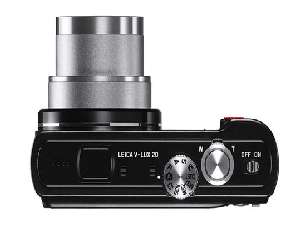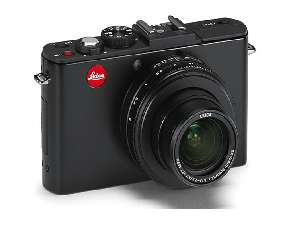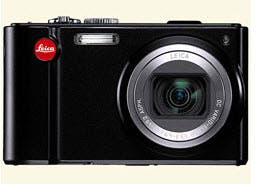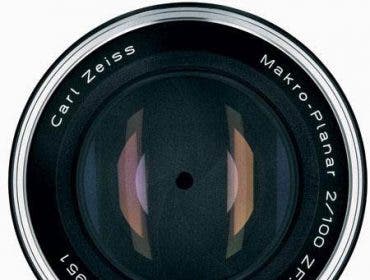With a 12X zoom lens, 12.1-megapixel sensor, built-in GPS, HD video, and full feature array its specs are impressive. Our resident Leica expert puts the Leica V-Lux 20 through its paces.

Key Fetures
- 12x (25-300mm equivalent) f/3.3-4.9 optical zoom lens
- 12.1MP CCD sensor
- 460,000-dot 3-inch LCD
- 29 scene modes
- ISO settings 80-1600
- 720p HD video with stereo sound
- Snapshot mode
Positives
- Excellent quality at low ISO
- Outstanding lens performance
- Improved Optical stabilization
Negatives
- Shutter lag
- No viewfinder
- High price
Price: Around $700 (as of June, 2010)
The new Leica V-LUX 20 was unveiled as the ultimate point-and-shoot digital camera for Leica fans, and it does indeed represent a considerable advance over previous Leica digital compacts. Unlike the Leica X1, which I reviewed here, a narrow-spectrum 35mm lens camera that delivers exceptional image quality and a true Leica M form factor, the broad-spectrum V-LUX 20 has been optimized to provide high performance along with extreme shooting flexibility.
Overview
For starters, the V-Lux 20 offers a 12X, 25-300mm-equivalent Leica DC Vario-Elmar f/3.3-4.9 ASPH zoom lens, a high-resolution 12.1MP CCD sensor with 3 aspect ratios, a brilliant 460,000-dot 3-inch LCD with auto brightness control, and an amazing array of modes and cutting-edge capabilities, all crammed into an elegant, crisply-styled body that’s slim enough to slide into a pants pocket. If you think this is hyperbole, consider that the V-LUX 20 provides a choice of 29 scene modes, 9 exposure modes, 3 metering modes, and ISO settings from 80-1600, and up to ISO 6400 in High Sensitivity Auto mode. It’s also the first of the breed with GPS geo-tagging of still and movie images and the first to offer 720p HD video with stereo sound recording.
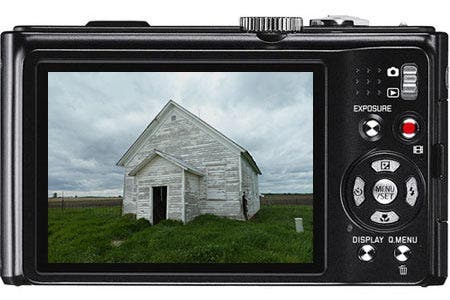
In the hands
Measuring 4-1/16 inches wide, 2-7/16 inches high and 1-9/32 inches deep and weighing in at 7-3/5 ounces complete with memory card and battery, the V-LUX 20 is engagingly compact and beautifully finished in satin black with chrome accents. Its semi-rounded ends and right-hand finger rest afford a secure, comfortable grip. The main power switch, zoom tab, shutter release and exposure mode dial are conveniently placed atop the camera and clearly labeled.
On the back, to the right of the big 3-inch (diagonal) LCD is the usual array of control buttons that let you display and set various menus depending on whether the topmost switch is set to shoot (camera icon) or to display (framed arrow icon) images. Considering the vast array of menus and sub-menus accessible by pressing the MENU/SET button in the shooting mode, it’s a good idea that you can display and control frequently used settings including ISO, image size, white balance, AF mode, movie resolution, and more by simply pressing the Q (Quick) Menu button. When you do the name of each function is clearly displayed for a few seconds at the bottom of the screen—a nice touch.
There’s also an array of specific function buttons arranged around the MENU/SET button that let you set exposure compensation (+/- 2EV in 1/3-stop increments), flash mode (including slow sync with or without red-eye reduction) macro and macro zoom, and self-timer (2- or 10-ec delay). The Display button scrolls through the various info displays (including “rule of thirds” lines) on the LCD by pushing it repeatedly, and the red Movie button starts and stops movies, which you can shoot at any time in any shooting mode except Clipboard (which captures a 1- or 2-magapixel reference image that you can zoom into and mark in Playback).

In addition to the P, A, S, M exposure modes, you can set the exposure mode dial atop the camera to two My Scene modes (MS1 and MS2), which will quickly set the camera to your favorite shooting modes. Set it to CUSTOM mode and you can quickly access any of 3 groups of user-programmed custom settings. The final exposure mode setting is in many ways the most interesting. Turn the dial to the “A in black camera outline” setting to select Intelligent Auto and the camera provides auto scene recognition (including portrait, baby, scenery, night portrait, macro, etc.) and displays the camera-selected-mode icon on the screen in blue for two seconds.
When you set Intelligent Auto, the words “Snapshot Mode” briefly appears on the LCD before they’re replaced with the iA logo, but don’t be fooled. While this mode may not let you set the ISO manually (it’s automatically set to Auto ISO), it does allow you to choose the subject for AF Tracking by pressing the up-arrow button, positioning the subject to be tracked in the displayed frame, and then pressing the down-arrow button to lock in the targeted subject and activate AF tracking. This feature alone takes it beyond the realm of the usual “push here, dummy” green mode found on many point-and shoots.
Indeed, at the iA setting, the camera optimizes the resolution (using Intelligent resolution) and exposure (using Intelligent ISO) so effectively that even experienced shooters may well prefer it to setting the image optimization modes manually. Another nice feature is Intelligent zoom that gives you and extra 1.3X of zoom—to 16X or 390mm at 12.1MP image size before the (resolution lowering) digital zoom kicks in.
Speaking of manual modes, when using the A (aperture priority), S(shutter priority) or M (manual) modes, you activate the manual exposure parameter setting feature by pressing the EXPOSURE button on the back of the camera. The appropriate setting or settings appear in yellow at the bottom of the screen along with directional arrows. For example in A mode with the lens set at its widest focal length a yellow f/3.3 appears with right-pointing arrow. Press the button to the right of the MENU/SET button to select smaller apertures (down to f/6.3, or scroll back with the left-hand button to select wider apertures.

Fishing on Lake Sugema, Keosauqua, Iowa. Shot at ISO 80, 49.2mm focal length (300mm equivalent), f/4.9 in Program mode. Waves and subtle hues in water are superbly rendered (note crisp detail in fishing rod on ground), and exposure for both highlights and shadows is excellent. Optical image stabilization helped achieve high image quality when shooting handheld at a long telephoto setting.
The aperture graphic changes as you zoom toward the telephoto end—the maximum aperture is now f/4.9, but the smallest is still f/6.3. Providing smaller apertures than that would have resulted in too much image-degrading diffraction with a small-sensor (1/2.33-inch) camera having such a tiny aperture diaphragm. Obviously, comprehensive depth-of field control is not this camera’s forte, but you can achieve aesthetic shallow depth of field effects by shooting wide open at the longest focal lengths.
Shutter speeds are not similarly restricted—in shutter-priority mode—you can make manual settings from 8 sec. to 1/2000 sec, and the camera will actually get down to 60 sec in Night Scene mode. In M mode, a linear exposure index is displayed, and when you press the Exposure button both the aperture and shutter speed indications appear along with directional arrows that can be set to center the exposure index to zero, or not depending on your preference.
Image quality at low, high ISO:

Building for rent, take 1: Image shot at ISO 100, 10.3mm focal length (63mm equivalent), f/4.0 in Program mode shows excellent detail (note For Rent sign, brickwork under windows), vibrant color saturation and accurate color in yellow clapboard, red bricks. 100% blow-up of center of image, below.


Building for rent, take 2: Shot at ISO 1600, 10.3mm focal length (63mm equivalent) f/6.3 in Program mode. Here detail is noticeably reduced by “digital grain” (compare with ISO 100 image), and color saturation is low, with muted color in bricks and yellow siding. Result is satisfactory for web posting or small prints. 100% blow-up of center of image, below.

In the field
Shooting with the V-LUX 20 is generally a very pleasant and rewarding experience, especially when the improved Optical Image Stabilization is activated. Based on my results I can confirm that, as claimed, it’s a significant advance over the O.I.S. built into previous Leica digital compacts. I was able to achieve a very high percentage of critically sharp images shooting at shutter speeds much slower than the time-honored one-over-the-focal-length rule and we’d estimate that the system provides a genuine 3-to-4-stop advantage in achieving shake-free handheld images.
The LCD is excellent, both for composing stills and movies, and for judging image quality of captured images at high magnification via the zoom control.
The performance of the Leica-designed DC Vario-Elmar ASPH zoom lens is also outstanding. A 10-element, 8-group design with two low-dispersion elements, two aspheric elements and a total of 3 aspheric surfaces it delivers first-rate imaging performance. Sharpness, contrast, and color fidelity at all apertures and focal lengths is exemplary, and aside from some barely discernible falloff in the extreme corners of the field at the widest-angle setting, and slight chromatic aberration at the focal-length extremes, it is flawless. Linear distortion, the bugaboo of long-range wide-to-telephoto zoom lenses, is less than ½ percent (barrel type) at the widest setting, and virtually zero as you move toward the long end—a commendable performance indeed.

Awkward expression, accurate exposure: Despite tricky lighting (and our hesitant model’s forced smile), the V-Lux 20’s Intelligent Auto mode aced the exposure and got good, accurate skin tones in auto mode at ISO 200. Image stabilazation assured the shot would be sharp.
Of course, the crispness and excellent color fidelity of the un-manipulated JPEGs shot at 12MP is partially attributable to the Leica-tweaked CCD sensor and state-of-the-art image processing system. The latter is also responsible for delivering blazing speed for a camera of this type. Shutter lag is a little under half a second for full AF, virtually instantaneous firing when the subject is pre-focused. The low-speed burst rate is a bit under 3fps for full-res images. At the high-speed continuous setting you can shoot 3MP images at up to 10fps for up to 100 pictures with a high-speed SDHC or SDXC card, and the camera has 15MB of built-in memory, albeit with slower uptake than an SD card.
Based on the CIPA standard, the compact 3.6.volt, 895mAh battery can shoot up to 300 pictures per charge. Flash power is decent, with a range of over 17 feet in Auto ISO at the wide-angle setting and around 12 feet at the telephoto setting, but power output is not adjustable, and you have to be carful not to place your fingers too high on the built in hand grip if you want to avoid the dreaded finger-over-flash syndrome. The quality of the flash illumination is better than average, yielding a pleasant degree of diffusion in most cases and the 5 flash modes are quite useful.
For a small sensor camera, the V-LUX 20 performs better than expected at elevated ISOs, whether you’re shooting movies or stills, but it does not come up to the level of large sensor cameras like the Leica X1, the Leica M9, or the current crop of DSLRs. You can easily make pro-quality 16×20-inch enlargements from sharp, properly exposed images shot at ISO 80 and 100, excellent 13x19s from images shot at ISO 200 and 400. At ISO 800 8x10s look very good indeed, but larger enlargements show minor luminance noise in the shadows. Shots taken at ISO 1600 are certainly useable, but detail is reduced, and they exhibit definite “digital grain” as well as de-saturated colors, especially in the yellows. The settings of ISO 3200 and 6400 in High Sensitivity mode are really provided for emergencies, when getting any image is preferable to none at all.
GPS: It knows where you are
The camera’s GPS system is also better than the ones in comparable compact digital cameras. There is a screen icon that clearly shows if the feature is enabled and displays the number of satellites it has synched with (3 is the minimum for accurate geo-tagging). There’s even a status screen that shows the sync in progress, when sync was last achieved, and where you are so you always know which images are tagged. Very cool.
GPS remains on when the camera is turned off (unless it is deactivated) and that does consume some battery power, so turning it off before long term storage is as good idea. Because of GPS and other features the V-LUX 20 is a great travel camera and its GPS system has 500,000 landmarks in 173 countries accessible by it GPS Area Play mode. After selecting one of these options the camera scans the stored images, shows an alphabetical list atop the screen and reads out the first landmark along with a thumbnail.
I was able to tag 6 separate locations in Iowa City, a mid-sized city in the Midwest, and it even worked pretty well in the small town of Catskill, New York. The landmark phrase displayed didn’t always correspond to the precise location of the camera, but it was usually pretty close. Note also that GPS is not a “set it and forget it” feature. You may have to re-sync it if it loses the signal or you move the camera to a location too far away from the one you originally synched to. However, it did respond correctly by displaying landmarks in Fairfield, Iowa, after synching it in Iowa City about 75 miles away.
It’s great to be able to call up the geographic coordinates and place names where pictures were taken when you return home from a trip or post tagged images on a social networking site like Facebook or the Google Earth map.
HD Video
Shooting videos is as easy as pressing the red Movie button (it’s labeled with a tiny film icon that’s hard to make out) to start the recording. 16:9 format options include Quick Time Motion JPEG HD movies at 1280×720 resolution and 60 fps, or WVGA 848×480 movies at 30 fps. In the 4:3 aspect ratio you can shoot Motion JPEG movies at VGA (640×480), or QVGA 320×240, both at 30 fps. You can also shoot movies in Scene Modes, and it’s easy but not exactly intuitive—simply set the Mode Dial to Scene mode and select the mode you want before shooting the movie!
The V-LUX 20 only records HD movies in Motion JPEG format which takes up more space on the memory card than AVCHD Lite, which uses frame blending to create smaller movie files. The downside is that you can only record an 8-minute movie on 2CB of card space. However, Motion JPEG does not require any time-consuming conversion in editing and it does deliver superior image quality if the editing experience on my Mac is any guide.
Movies shot with the camera look spectacular when they’re played on a large HD TV screen, and the stereo sound recorded is impressive when it’s played through a decent stereo system (not monaurally through the camera). All things being equal we would have preferred to have the movie start/stop button positioned on top of the camera to provide a smoother release, but we got used to it and shot some very satisfying footage.
Conclusion and recommendation
On balance, I feel that the Leica V-LUX 20 performs to a very high standard overall and will certainly please Leica fans looking for a high-performance digital compact, pro Leica shooters seeking a competent pocket-sized backup camera, and enthusiasts who simply want to own a fine-performing, Leica without paying thousands of dollars. Among it its many plus points are a first class 12X Leica lens, cutting-edge image processing, state-of-the-art optical image stabilization, 4:3, 32 and 16:9 aspect ratios, advanced GPS, instant HD movie capability, programmable Face Recognition, fast AF speed and very low shutter lag. No it’s not the fastest camera in full-res burst mode and the flash is OK but not up to the standard set by the rest of the camera.
Yes, the Panasonic Lumix ZS7 costs less and is very similar to the Leica V-LUX 20, but according to Leica, the sensor and image processing software in the V-LUX have been tweaked for better performance and its minimalist cosmetics are a bit more refined. With the Leica you also you get the renowned Leica logo and the pride of possession that goes with it, plus Leica quality control and a two-year Leica warranty.
